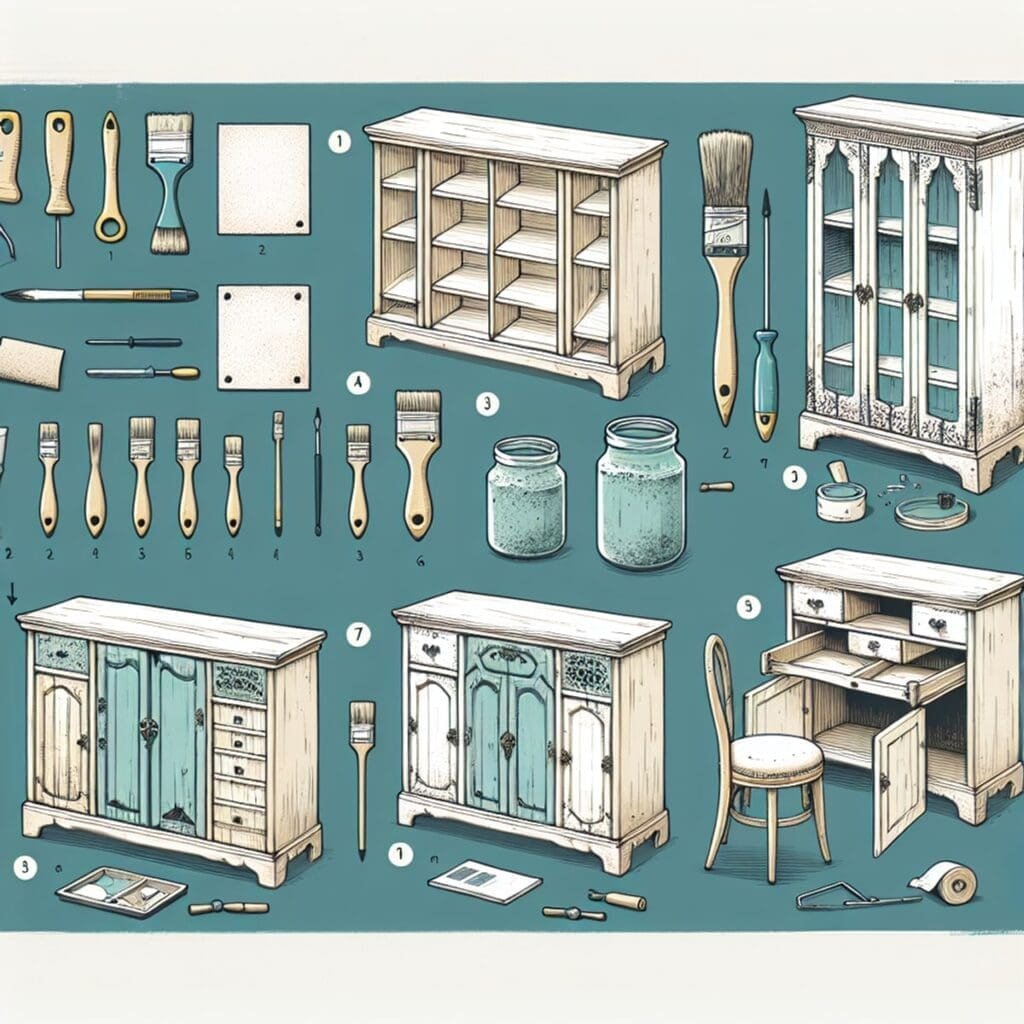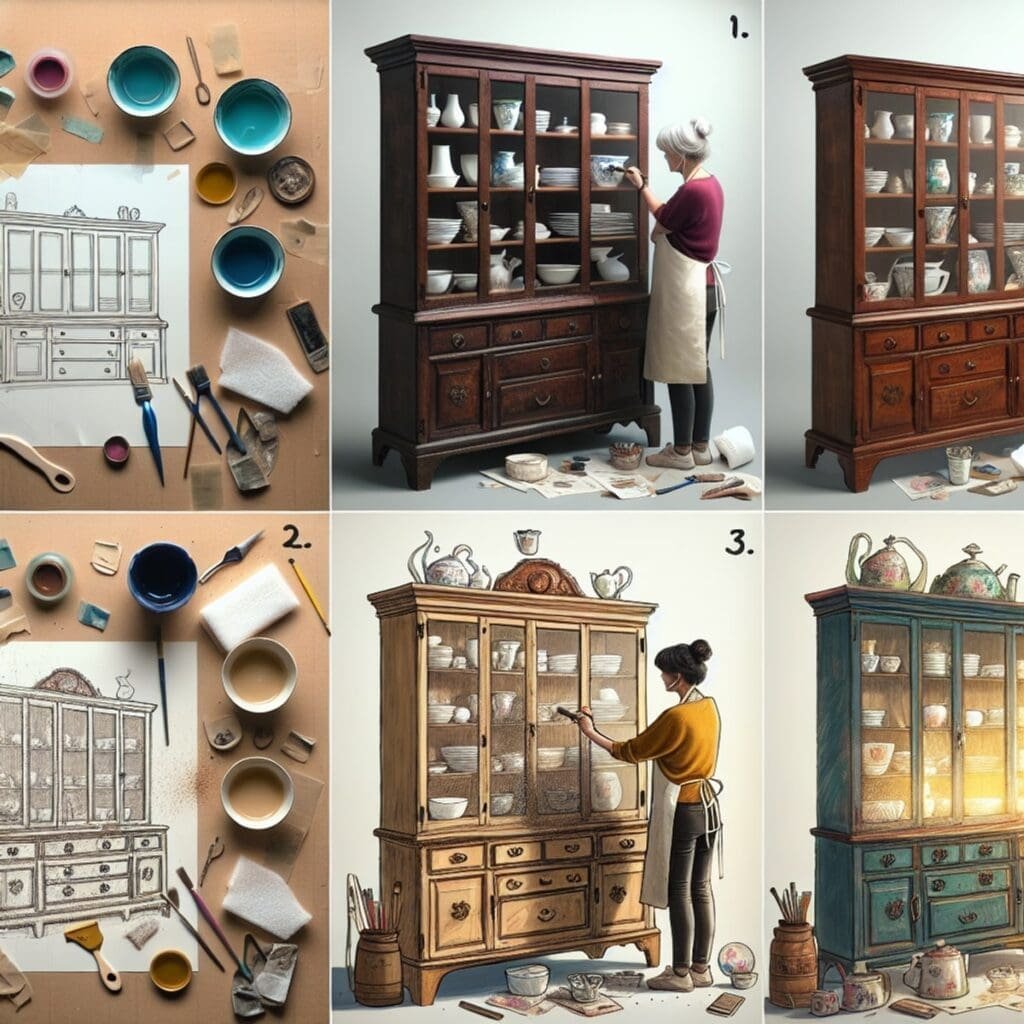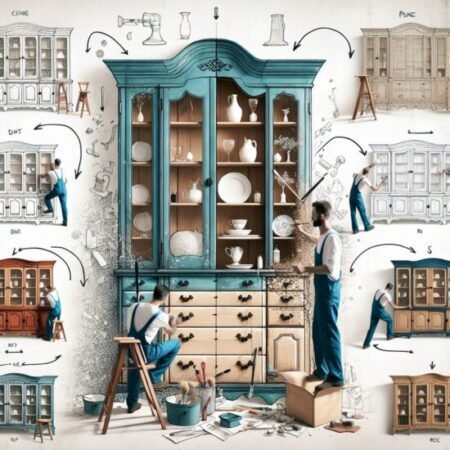
Introduction to Repurpose a China Cabinet
Repurposing furniture is a creative and sustainable way to breathe new life into old pieces, reducing waste and adding unique character to your home decor.
The growing popularity of upcycling reflects a shift towards sustainable living and a desire for personalized, one-of-a-kind home furnishings.
In this article, we’ll explore 5 brilliant ideas to repurpose a china cabinet, offering a range of options from simple DIY projects to innovative furniture transformations.
1. Pairing Natural Wood Tones with Color
When it comes to repurposing a china cabinet, one brilliant idea is to pair natural wood tones with pops of color. This combination can give a modern twist to the cabinet and create a unique focal point in your space. Here are some talking points to consider:
- Key Idea: By incorporating both natural wood elements and vibrant colors, you can achieve a balanced and visually appealing look for your china cabinet makeover.
- Selecting the Perfect Paint Colors: When choosing paint colors for your cabinet, it’s important to consider the wood grain and select hues that complement it. For example, if your china cabinet has warm-toned wood, you might opt for rich earthy colors like deep reds or burnt oranges. On the other hand, if your cabinet has cooler-toned wood, you could choose shades of blue or green to create a striking contrast. This article on color and wood tone provides further insights into finding the perfect combination.
- Refinishing the Cabinet Surface: Before applying paint, it’s essential to properly prepare the cabinet surface to highlight its natural beauty. You may need to sand down any rough areas or remove old varnish or paint. Once the surface is smooth and clean, you can apply a primer to ensure better adhesion of the paint and then proceed with adding color.
Pairing natural wood tones with color is an excellent way to transform a china cabinet. It allows you to preserve the warmth of the wood while infusing personality and style through vibrant paint choices. By following these tips for selecting paint colors and refinishing the surface, you can achieve a cohesive and eye-catching furniture makeover.
2. Adding Interesting Details with Decoupage

Decoupage is a fantastic technique for adding artistic flair to a china cabinet. Here’s how you can use decoupage to transform your furniture:
Key Idea: Decoupage is a creative way to embellish a china cabinet, allowing you to add unique and personalized details.
Step-by-step Instructions:
- Start by gathering your supplies, including decorative paper or fabric, decoupage medium, and a foam brush.
- Prepare the cabinet surface by cleaning it thoroughly and sanding it lightly to create a smooth base for the decoupage.
- Cut the decorative paper or fabric to fit the areas you want to cover on the cabinet doors or sides.
- Apply a thin layer of decoupage medium to the back of the paper or fabric and carefully smooth it onto the cabinet surface, ensuring there are no air bubbles or wrinkles.
- Once dry, apply additional coats of decoupage medium over the top of the paper or fabric to seal and protect it.
Unique Themes or Patterns:
- Consider using vintage botanical prints for a classic, timeless look.
- Experiment with geometric designs to add modern and abstract elements to your cabinet.
By embracing decoupage, you can infuse your china cabinet with your personal style and create a one-of-a-kind piece that adds charm and character to your home.
3. Repurposing the Top Section into a Different Function

Repurposing the top section of a china cabinet can breathe new life into an old piece of furniture and add functionality to your space. By separating the china hutch from the base, you can create two distinct pieces that can be used in different ways. Here are some practical steps and ideas for transforming the top section into a unique and functional item:
1. Safely Detaching the Hutch
Before you begin repurposing the top section, it’s important to safely detach it from the base. Carefully remove any screws or fasteners that are holding the hutch in place. Make sure to support the weight of the hutch as you detach it to prevent any damage.
2. Display Shelf for Collectibles
Once you have separated the hutch, consider turning it into a shadow box display shelf for your collectibles or favorite items. You can remove any glass doors or shelves that were originally part of the china cabinet and replace them with open shelves. Paint or refinish the shelves to match your decor and arrange your collectibles in an aesthetically pleasing way. If you’re concerned about making it flush against the wall, you can follow some IKEA hacks to resolve this issue.
3. Hanging Bookcase in the Living Room
Another creative idea is to repurpose the top section into a hanging bookcase in your living room using shadow box shelves. Attach brackets or hooks to the back of the hutch and secure it to the wall at a suitable height. This will create a unique and functional storage solution for your books, magazines, or decorative items.
By repurposing the top section of a china cabinet, you can transform it into something entirely different and functional for your home. Whether you choose to create a display shelf for collectibles or a hanging bookcase in your living room, this creative approach allows you to make the most out of your old furniture while adding character and style to your space.
4. Unique Display with White, Light, or Neutral Colors

When it comes to repurposing a china cabinet, one of the most classic and elegant options is to paint it with white, light, or neutral colors. This choice allows you to create a timeless look that showcases the cabinet’s contents while seamlessly blending with various decor styles.
Using subtle hues for your painted finish offers several advantages:
- Enhances overall aesthetic: White, light, or neutral colors provide a clean and fresh backdrop that highlights the beauty of your china and other items on display. The simplicity of these colors allows the focus to remain on the pieces themselves, creating a visually pleasing arrangement.
- Maintains versatility: By opting for white, light, or neutral shades, you create a versatile piece of furniture that can easily adapt to different design schemes. Whether your style is farmhouse chic, Scandinavian minimalism, or coastal charm, a china cabinet painted in these colors will seamlessly fit into your chosen aesthetic.
To inspire you further, here are some beautiful examples of painted china cabinets in various neutral color schemes:
- Crisp White: A solid white paint job gives your china cabinet a fresh and clean look that works well in any setting. It creates a stunning contrast against colorful dishes or can be used to display delicate white porcelain pieces for an ethereal effect.
- Soft Gray: Gray is a popular choice for those seeking a more contemporary feel. This neutral shade adds sophistication and elegance to your china cabinet while still maintaining a subtle and understated appearance.
- Creamy Beige: If you prefer warmer tones, consider painting your china cabinet in a creamy beige color. This soft hue creates a cozy and inviting atmosphere while allowing your displayed items to take center stage.
By utilizing white, light, or neutral colors in your china cabinet transformation, you can achieve a unique display that is both sophisticated and versatile. Let your creativity shine as you reimagine this piece of furniture with a fresh coat of paint.
5. Making a Statement with Bold Colors
When it comes to revamping a china cabinet, why not embrace boldness and opt for vibrant and daring colors? Adding a pop of bold color can transform a china cabinet into a striking statement piece that adds personality to any space. Here are some strategies to help you choose the right bold hue and create a focal point without overwhelming the room:
Consider the Space
Before selecting a bold color, take into account the overall color scheme and style of the room as this will influence your decision-making process. You want to choose a shade that complements the existing decor while still standing out. For example, if you have a predominantly neutral color palette, a bold blue or deep emerald green can create a stunning contrast.
Test Swatches
It’s always a good idea to test swatches of your chosen bold colors on the cabinet before committing to painting the entire piece. This will give you an idea of how the color looks in different lighting conditions and how it interacts with the rest of the room. Websites like Kind Home Solutions offer comprehensive guides on selecting the perfect paint color for your home, which can be helpful during this stage.
Use Accents
If you’re hesitant about painting the entire cabinet in a bold color, consider using it as an accent instead. Paint only the doors or drawers in your chosen shade, while leaving the rest of the cabinet in a more neutral tone. This way, you can still achieve that eye-catching effect without overwhelming the space. Maria Killam, an expert in interior design, suggests a similar approach when choosing an accent chair.
Recommended Bold Paint Shades
Looking for some specific paint shades that work well for creating a focal point? Consider these eye-catching options:
- Emerald Green: A rich and luxurious hue that brings depth and sophistication.
- Klein Blue: A vibrant shade of blue that exudes energy and adds a modern touch.
- Coral Crush: A lively and playful coral shade that instantly brightens up any room.
- Mermaid Tail: A mesmerizing teal color that evokes a sense of whimsy and enchantment.
- Plum Crazy: A deep and mysterious shade of purple that adds drama and elegance.
By embracing bold colors when revamping your china cabinet, you can create a stunning focal point that adds excitement and personality to your space. Don’t be afraid to experiment with different shades and techniques to achieve the desired effect. Remember, it’s all about making a statement and showcasing your unique style.
More Ideas for Repurposing a China Cabinet
When it comes to repurposing a china cabinet, the possibilities are truly endless. Beyond the five brilliant ideas mentioned earlier, here are a few more creative ways you can give new life to an old china cabinet:
1. Storage in a Laundry Room
Convert the china cabinet into a practical storage solution in your laundry room. Remove the shelves and replace them with baskets or bins to store laundry essentials like detergent, fabric softener, and cleaning supplies. The cabinet doors can be used to hide away unsightly items or hang hooks for drying clothes.
2. Butler’s Pantry
Transform the china cabinet into a stylish and functional butler’s pantry. Remove the doors and paint the interior shelves with a fresh coat of paint. Use the top section to display glassware or decorative items, while the bottom section can be utilized for storing serving dishes, linens, and other entertaining essentials.
3. Repurposed Countertop and Sink
Take your creativity a step further by repurposing the top of the china cabinet as a countertop. Install a sink into the cabinet and create a unique vanity for your bathroom or powder room. This unexpected twist will add character and charm to any space.
These additional ideas showcase how versatile a china cabinet can be when it comes to repurposing. Whether you need extra storage in your laundry room or want to create a functional yet stylish bar area, upcycling a china cabinet allows you to make use of this furniture piece in unexpected and exciting ways.
Techniques for Refurbishing and Upcycling Furniture
When it comes to refurbishing and upcycling furniture, there are several techniques that can be applied not only to china cabinets but also to other furniture restoration projects. These techniques will help you transform old and worn-out pieces into beautiful and functional items for your home. Here are some ideas:
1. Refinishing
Refinishing is a great way to restore the original beauty of a piece of furniture. You can start by sanding down the surface to remove any existing finish or imperfections. Then, apply a new stain or paint using creative painting techniques to give it a fresh look. This technique is perfect for bringing out the natural wood grain of a china cabinet.
2. Creative Painting Techniques
Painting is another popular method for upcycling furniture. You can experiment with different techniques to create unique and eye-catching finishes. Some creative painting techniques include:
- Ombre: This technique involves blending two or more colors together to create a gradient effect. It can add depth and dimension to your china cabinet.
- Stenciling: Stenciling allows you to add intricate patterns or designs to your furniture, as shown in this helpful guide on stenciling furniture. You can use stencils to create a custom look on the doors or sides of your china cabinet.
3. Hardware Replacement
Swapping out old hardware with new ones can make a significant difference in the overall appearance of your furniture. Consider replacing outdated handles or knobs with modern and stylish options that complement the style of your china cabinet.
By applying these techniques, you can breathe new life into your old furniture and create one-of-a-kind pieces that reflect your personal style. So go ahead and unleash your creativity to transform your china cabinet into something truly remarkable!
Conclusion
Repurposing and upcycling old furniture not only allows us to reduce waste but also creates unique pieces with personal meaning.
By giving a second life to a china cabinet, we contribute to a more sustainable future and add character and style to our homes in unexpected ways.
Start your own china cabinet repurposing project armed with the knowledge and inspiration shared in this article.
FAQs (Frequently Asked Questions)
What is the concept of repurposing furniture and its benefits?
Repurposing furniture involves finding new and creative ways to use old pieces, which not only reduces waste but also allows for the creation of unique and personalized items with sentimental value.
Why is upcycling becoming a popular sustainable home decor trend?
Upcycling is gaining popularity as a sustainable home decor trend due to its positive impact on the environment by reducing waste, as well as the opportunity it provides to create one-of-a-kind pieces for home decoration.
What are some ideas for repurposing a china cabinet mentioned in the article?
The article discusses 5 brilliant ideas for repurposing a china cabinet, including pairing natural wood tones with color, adding interesting details with decoupage, transforming the top section into a different function, creating unique displays with white, light, or neutral colors, and making a statement with bold colors.
How can natural wood tones be paired with color to give a modern twist to a china cabinet?
Combining natural wood elements with pops of color can give a modern twist to a china cabinet. The article provides guidance on selecting paint colors that complement the wood grain and tips for refinishing the cabinet surface to highlight its natural beauty before applying paint.
What technique is suggested for adding interesting details to a china cabinet?
The article suggests using decoupage as a creative way to embellish a china cabinet. It provides step-by-step instructions for incorporating decorative paper or fabric onto the cabinet doors or sides using decoupage medium, along with unique themes or patterns that can be explored through decoupage.
How can the top section of a china cabinet be repurposed into a different function?
Readers are encouraged to think beyond traditional uses by repurposing the upper part of a china cabinet. The article offers practical steps for safely detaching the hutch from the base to create two distinct pieces of furniture, along with ideas for transforming the top section into functional items like display shelves or hanging bookcases.






